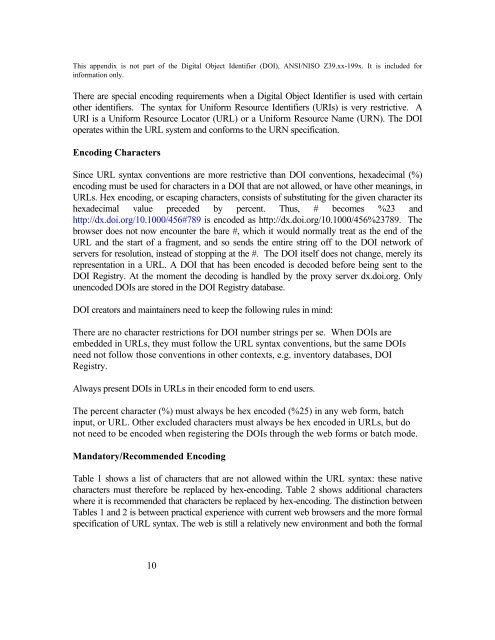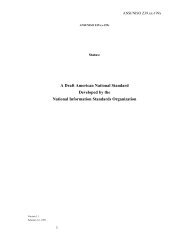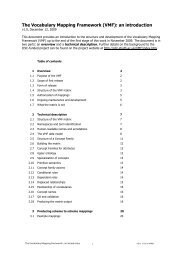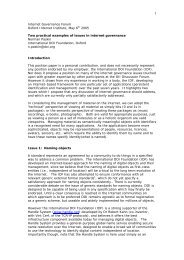Digital Object Identifier - DOIs
Digital Object Identifier - DOIs
Digital Object Identifier - DOIs
You also want an ePaper? Increase the reach of your titles
YUMPU automatically turns print PDFs into web optimized ePapers that Google loves.
This appendix is not part of the <strong>Digital</strong> <strong>Object</strong> <strong>Identifier</strong> (DOI), ANSI/NISO Z39.xx-199x. It is included for<br />
information only.<br />
There are special encoding requirements when a <strong>Digital</strong> <strong>Object</strong> <strong>Identifier</strong> is used with certain<br />
other identifiers. The syntax for Uniform Resource <strong>Identifier</strong>s (URIs) is very restrictive. A<br />
URI is a Uniform Resource Locator (URL) or a Uniform Resource Name (URN). The DOI<br />
operates within the URL system and conforms to the URN specification.<br />
Encoding Characters<br />
Since URL syntax conventions are more restrictive than DOI conventions, hexadecimal (%)<br />
encoding must be used for characters in a DOI that are not allowed, or have other meanings, in<br />
URLs. Hex encoding, or escaping characters, consists of substituting for the given character its<br />
hexadecimal value preceded by percent. Thus, # becomes %23 and<br />
http://dx.doi.org/10.1000/456#789 is encoded as http://dx.doi.org/10.1000/456%23789. The<br />
browser does not now encounter the bare #, which it would normally treat as the end of the<br />
URL and the start of a fragment, and so sends the entire string off to the DOI network of<br />
servers for resolution, instead of stopping at the #. The DOI itself does not change, merely its<br />
representation in a URL. A DOI that has been encoded is decoded before being sent to the<br />
DOI Registry. At the moment the decoding is handled by the proxy server dx.doi.org. Only<br />
unencoded <strong>DOIs</strong> are stored in the DOI Registry database.<br />
DOI creators and maintainers need to keep the following rules in mind:<br />
There are no character restrictions for DOI number strings per se. When <strong>DOIs</strong> are<br />
embedded in URLs, they must follow the URL syntax conventions, but the same <strong>DOIs</strong><br />
need not follow those conventions in other contexts, e.g. inventory databases, DOI<br />
Registry.<br />
Always present <strong>DOIs</strong> in URLs in their encoded form to end users.<br />
The percent character (%) must always be hex encoded (%25) in any web form, batch<br />
input, or URL. Other excluded characters must always be hex encoded in URLs, but do<br />
not need to be encoded when registering the <strong>DOIs</strong> through the web forms or batch mode.<br />
Mandatory/Recommended Encoding<br />
Table 1 shows a list of characters that are not allowed within the URL syntax: these native<br />
characters must therefore be replaced by hex-encoding. Table 2 shows additional characters<br />
where it is recommended that characters be replaced by hex-encoding. The distinction between<br />
Tables 1 and 2 is between practical experience with current web browsers and the more formal<br />
specification of URL syntax. The web is still a relatively new environment and both the formal<br />
10






